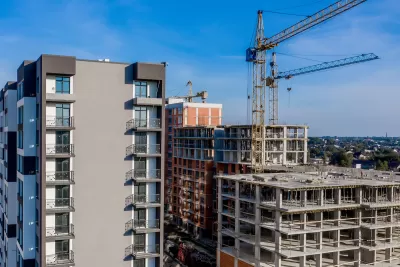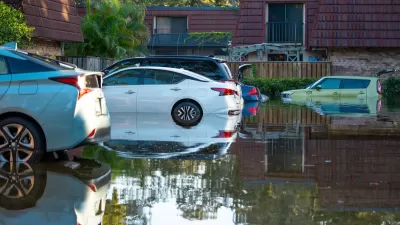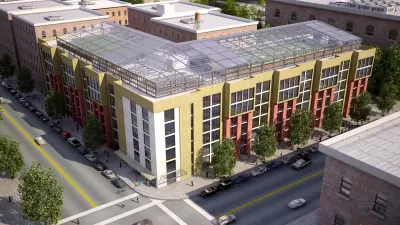Rapidly rising insurance premiums are forcing affordable housing developers to cut back on programming, lay off staff, and even sell. To add insult to injury, some insurers also seem to be adding penalties or withdrawing coverage for housing voucher holders.

Las Brisas is a sprawling, two-story 68-unit apartment building in central Houston that resembles a motel. Since buying the property in 2012, local community developer Avenue has operated it as affordable housing, with rents as low as $720. As the neighborhood began to gentrify, with vintage shops and indie theaters springing up nearby, developers made repeated efforts to buy Las Brisas from Avenue. Avenue, however, was committed to its affordable housing mission and until recently had been planning to rebuild new affordable housing on the site.
But recent astronomical increases in insurance premiums changed the calculus for Avenue. Avenue CEO Mary Lawler says their insurance costs have increased by more than $1 million in the past few years. Insurance premiums on one Avenue property doubled last year and have tripled since 2020. “Our projected loss on our overall portfolio is now about $1 million,” says Lawler. “Not every property has always made money, but some properties were throwing off positive cash flow, and that could help to support properties that weren’t. But the whole portfolio is basically losing money at this point. We can’t go on like that.”
Avenue put Las Brisas on the market in January and has already received several offers. Lawler expects that the future buyer will demolish the property and build new market-rate units on the lot, meaning that Houston, already in a housing crisis, will lose a valuable block of affordable housing. It’s a story that could become much more common across the U.S. as owners and developers of affordable housing are squeezed by property insurance rates that, for some developers we spoke with, have more than quadrupled.
Insurers have raised premiums for property and liability insurance for all types of property for several years running, citing impacts from extreme weather events caused by climate change, the lightly regulated international reinsurance market, and rising rebuilding costs. In states like California and Florida, which have been hit hard by wildfires, flooding, and hurricanes, many big insurance companies have either stopped writing new policies or left the state entirely, resulting in less competition and higher premiums for flimsier policies with more exclusions.
Insurance companies defend these rate increases as necessary to remain solvent, but recent reports of record profits suggest that’s not entirely the case. And many affordable housing advocates contend the industry is using legitimate climate change risk issues as cover to illegally raise costs for or deny coverage specifically to properties that house tenants using Section 8 vouchers.
With the U.S. already in a severe housing affordability crisis, skyrocketing insurance rates threaten to reduce the amount of affordable housing stock by rendering older units uninsurable and stalling or even canceling projects in developer pipelines. In the absence of a rapid policy response from state and federal government, many developers of affordable housing say these price increases represent a grave and perhaps existential threat.
“There’s going to have to be policy and other solutions developed within the next two years,” says Erich Nakano, executive director at Los Angeles-based community developer Little Tokyo Service Center. “Otherwise we’re going to see a lot of buildings start to go under.”
Hitting affordable housing hard
Rapidly rising premiums have affected all U.S. property owners, but properties that provide housing affordable to lower income households have been hit hard. Fifty to 70 percent of the portfolio of Holos Communities in North Hollywood, California, is occupied by formerly chronically homeless individuals. Insurance costs on that housing that have gone from an average of $400 per unit per year to over $1,800 in a single year.
While private homeowners can choose to forgo insurance when premiums become unaffordable—an increasingly common practice sometimes referred to as “going bare”—affordable housing developers don’t have this option. (Nor would it be responsible to do so.) Owners of market-rate rental housing can pass increased insurance costs onto tenants, but many affordable housing operators are limited in how much rent they can charge. (And even when they’re not precluded from increasing rents, it’s often incompatible with their mission.)
And it’s not just a matter of having some insurance. Affordable housing developments are financed with a mixture of public and private money, and each lender and equity investor comes with their own insurance requirements.
FULL STORY: Soaring Property Insurance Rates Threaten Affordable Housing Development

Study: Maui’s Plan to Convert Vacation Rentals to Long-Term Housing Could Cause Nearly $1 Billion Economic Loss
The plan would reduce visitor accommodation by 25,% resulting in 1,900 jobs lost.

Alabama: Trump Terminates Settlements for Black Communities Harmed By Raw Sewage
Trump deemed the landmark civil rights agreement “illegal DEI and environmental justice policy.”

North Texas Transit Leaders Tout Benefits of TOD for Growing Region
At a summit focused on transit-oriented development, policymakers discussed how North Texas’ expanded light rail system can serve as a tool for economic growth.

Paris Bike Boom Leads to Steep Drop in Air Pollution
The French city’s air quality has improved dramatically in the past 20 years, coinciding with a growth in cycling.

Why Housing Costs More to Build in California Than in Texas
Hard costs like labor and materials combined with ‘soft’ costs such as permitting make building in the San Francisco Bay Area almost three times as costly as in Texas cities.

San Diego County Sees a Rise in Urban Coyotes
San Diego County experiences a rise in urban coyotes, as sightings become prevalent throughout its urban neighbourhoods and surrounding areas.
Urban Design for Planners 1: Software Tools
This six-course series explores essential urban design concepts using open source software and equips planners with the tools they need to participate fully in the urban design process.
Planning for Universal Design
Learn the tools for implementing Universal Design in planning regulations.
Smith Gee Studio
Alamo Area Metropolitan Planning Organization
City of Santa Clarita
Institute for Housing and Urban Development Studies (IHS)
City of Grandview
Harvard GSD Executive Education
Toledo-Lucas County Plan Commissions
Salt Lake City
NYU Wagner Graduate School of Public Service





























